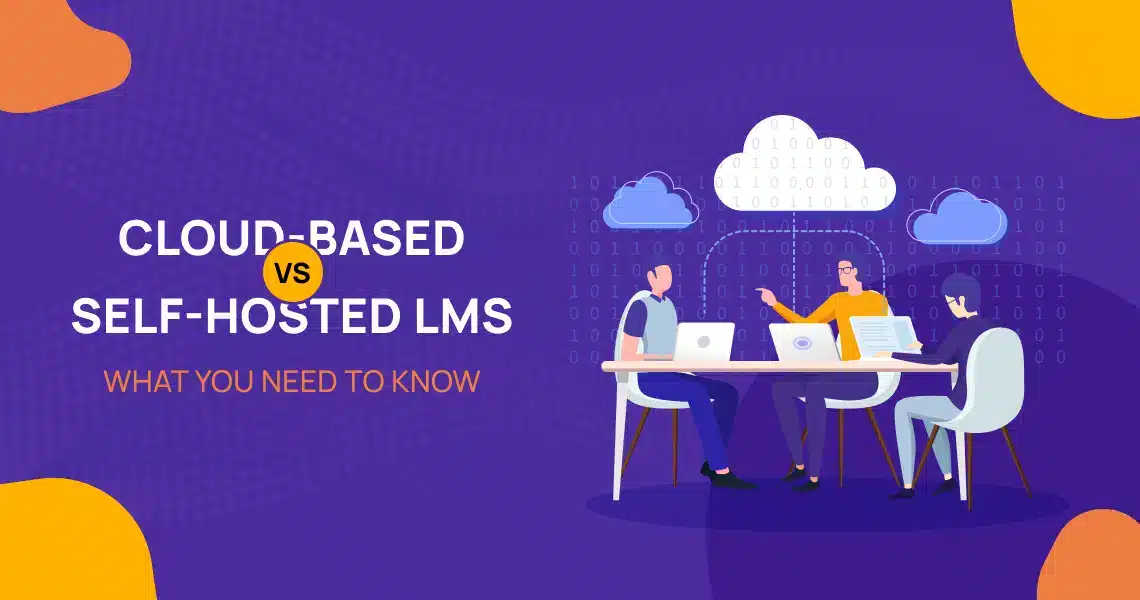As technology advances, many businesses and educational institutions have opted to use Learning Management Systems (LMS) to manage their learning materials, courses, and students. LMSs are software applications that make e-learning easier by providing a platform for online course delivery, tracking progress, and managing resources. However, when it comes to selecting the best LMS, there are two primary options: cloud-based and self-hosted. In this blog post, we will explore the pros and cons of each option, giving you an idea of what you need to know before choosing one for your organization.
First, let’s define cloud-based and self-hosted LMSs.
A cloud-based LMS is hosted on the vendor’s servers, and users can access it via the internet. With this option, there is no need to purchase or install any software, and the vendor handles maintenance and updates. Users only pay a subscription fee to access the system.
On the other hand, a self-hosted LMS requires a separate server to be installed on the organization’s premises. The user organization is responsible for purchasing, installing, and maintaining the software. This option provides more flexibility and control over the system, but it requires more technical knowledge and resources.
Now, let’s dive into the advantages and disadvantages of both types of LMSs.
Hire on-demand dedicated developers of desired skill & experience.
Cloud-Based LMS
Advantages:
Accessibility: A cloud-based LMS is accessible from anywhere in the world, as long as there is an internet connection. This means that users can access their courses and materials on any device, including smartphones, tablets, laptops, or desktop computers.
Scalability: A cloud-based LMS can easily accommodate a growing user base, as the vendor’s servers can be upgraded to handle more users. Additionally, users only pay for what they need, making it more cost-effective than a self-hosted LMS for smaller organizations.
Ease of Use: Since the vendor handles maintenance and upgrades, users don’t need to worry about technical issues. The LMS provider takes care of everything, making it a simple and user-friendly option for organizations that don’t have an IT department.
Disadvantages:
Security: Since data is stored on the vendor’s servers, there is always a risk of a data breach. While reputable LMS providers have strong security measures in place, some organizations may prefer to keep their data on their premises.
Limited Control: With a cloud-based LMS, users have limited control over the system’s functionality and customization. The vendor may not allow certain integrations or customization, which can limit the user experience.
Dependence on the Vendor: Organizations that use a cloud-based LMS are dependent on the vendor for system uptime, maintenance, and updates. If the vendor experiences downtime or technical issues, it can affect the organization’s ability to deliver courses and manage student data.
Self-Hosted LMS
Advantages:
Control: With a self-hosted LMS, users have complete control over the system’s functionality and customization. The user organization can modify and extend the LMS as needed, making it more flexible and customizable. /p>
Security: Since data is stored on the organization’s server, there is more control over security measures, making it easier to implement and maintain security protocols. This option is ideal for organizations that handle sensitive data.
Cost-Effective: Although there are initial costs associated with purchasing and installing the software, self-hosted LMSs can be more cost-effective in the long run. Organizations only need to pay for maintenance, upgrades, and hosting, which can be less expensive than a subscription-based cloud LMS.
Hire dedicated team for your next web development project.
Disadvantages:
Technical Knowledge: Setting up a self-hosted LMS requires more technical knowledge and resources than a cloud-based LMS.
Maintenance: Maintaining a self-hosted LMS can be time-consuming and requires technical expertise. Organizations must ensure that the software is up-to-date and secure, which can be a challenge for organizations with limited technical resources.
Limited Accessibility: Since a self-hosted LMS is hosted on the organization’s server, it is only accessible within the organization’s network. This means that users cannot access the LMS outside of the organization’s premises, which can be a drawback for remote learners.
Now that we have discussed the pros and cons of both cloud-based and self-hosted LMSs, let’s consider some factors that can help you decide which one is right for your organization.
Budget: The cost of implementing and maintaining an LMS is a crucial factor for most organizations. A self-hosted LMS requires an upfront investment in software, hardware, and technical resources, whereas a cloud-based LMS is subscription-based and can be more cost-effective for smaller organizations.
Technical Expertise: Implementing and maintaining a self-hosted LMS requires technical expertise, while a cloud-based LMS requires minimal technical knowledge. If your organization has an IT department, a self-hosted LMS might be a good option, while a cloud-based LMS might be better for organizations without technical expertise.
Security Requirements: If your organization handles sensitive data, a self-hosted LMS might be a better option. Organizations can control the security measures and protocols for their data, ensuring that it is secure. However, cloud-based LMS providers often have strong security measures in place, making them a safe option for most organizations.
Scalability: If your organization anticipates significant growth in the number of users or courses, a cloud-based LMS is a more scalable option. Cloud-based LMS providers can easily accommodate a growing user base, while a self-hosted LMS may require significant upgrades to handle increased usage.
Accessibility: If your organization has remote learners, a cloud-based LMS is a better option. Cloud-based LMSs can be accessed from anywhere with an internet connection, making it more accessible for learners who are not on-premises.
In conclusion, choosing between a cloud-based and self-hosted LMS depends on several factors, including budget, technical expertise, security requirements, scalability, and accessibility. While both options have their advantages and disadvantages, organizations should consider their unique needs and requirements before making a decision. We hope this article has provided you with the information you need to choose the right LMS for your organization.
Do you need further assistance in selecting the appropriate LMS hosting option for your online courses? Feel free to reach out to us for support.





